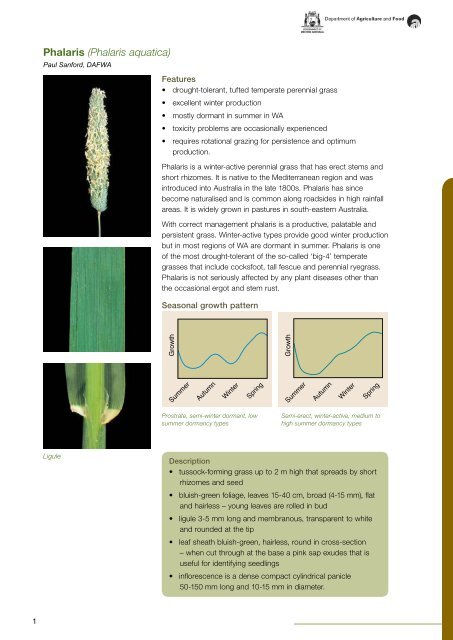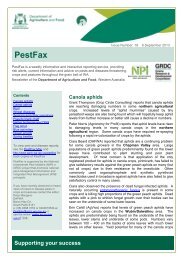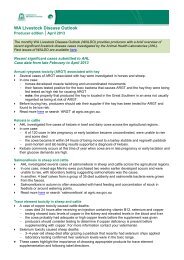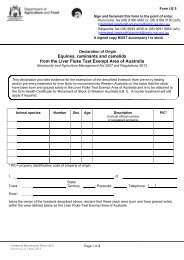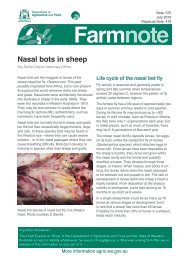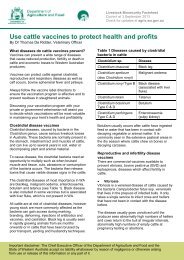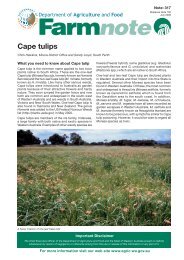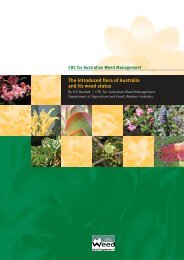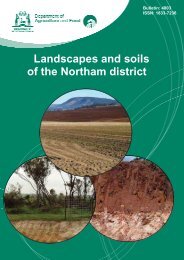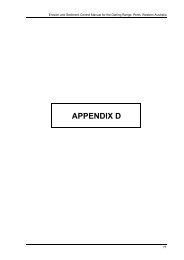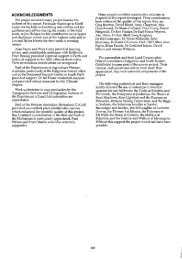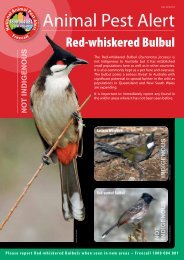Phalaris (Phalaris aquatica) - Department of Agriculture and Food
Phalaris (Phalaris aquatica) - Department of Agriculture and Food
Phalaris (Phalaris aquatica) - Department of Agriculture and Food
Create successful ePaper yourself
Turn your PDF publications into a flip-book with our unique Google optimized e-Paper software.
1<br />
<strong>Phalaris</strong> (<strong>Phalaris</strong> <strong>aquatica</strong>)<br />
Paul Sanford, DAFWA<br />
Ligule<br />
Features<br />
• drought-tolerant, tufted temperate perennial grass<br />
• excellent winter production<br />
• mostly dormant in summer in WA<br />
• toxicity problems are occasionally experienced<br />
• requires rotational grazing for persistence <strong>and</strong> optimum<br />
production.<br />
<strong>Phalaris</strong> is a winter-active perennial grass that has erect stems <strong>and</strong><br />
short rhizomes. It is native to the Mediterranean region <strong>and</strong> was<br />
introduced into Australia in the late 1800s. <strong>Phalaris</strong> has since<br />
become naturalised <strong>and</strong> is common along roadsides in high rainfall<br />
areas. It is widely grown in pastures in south-eastern Australia.<br />
With correct management phalaris is a productive, palatable <strong>and</strong><br />
persistent grass. Winter-active types provide good winter production<br />
but in most regions <strong>of</strong> WA are dormant in summer. <strong>Phalaris</strong> is one<br />
<strong>of</strong> the most drought-tolerant <strong>of</strong> the so-called ‘big-4’ temperate<br />
grasses that include cocksfoot, tall fescue <strong>and</strong> perennial ryegrass.<br />
<strong>Phalaris</strong> is not seriously affected by any plant diseases other than<br />
the occasional ergot <strong>and</strong> stem rust.<br />
Seasonal growth pattern<br />
Growth<br />
Summer<br />
Autumn<br />
Winter<br />
Spring<br />
Prostrate, semi-winter dormant, low<br />
summer dormancy types<br />
Description<br />
• tussock-forming grass up to 2 m high that spreads by short<br />
rhizomes <strong>and</strong> seed<br />
• bluish-green foliage, leaves 15-40 cm, broad (4-15 mm), flat<br />
<strong>and</strong> hairless – young leaves are rolled in bud<br />
• ligule 3-5 mm long <strong>and</strong> membranous, transparent to white<br />
<strong>and</strong> rounded at the tip<br />
• leaf sheath bluish-green, hairless, round in cross-section<br />
– when cut through at the base a pink sap exudes that is<br />
useful for identifying seedlings<br />
• inflorescence is a dense compact cylindrical panicle<br />
50-150 mm long <strong>and</strong> 10-15 mm in diameter.<br />
Growth<br />
Summer<br />
Autumn<br />
Winter<br />
Spring<br />
Semi-erect, winter-active, medium to<br />
high summer dormancy types
Temperate perennial grasses<br />
Soil–climate adaptation<br />
Rainfall (est.): >500 mm<br />
(south coast >400 mm)<br />
Season length: >6 months<br />
Drought tolerance: High<br />
Frost tolerance: High<br />
Soil type: Deep medium- to fine-textured, will<br />
grow on coarse-textured if clay within 30 cm<br />
<strong>of</strong> surface<br />
Soil fertility requirements: High<br />
Soil pH Ca : >4.7<br />
Aluminium tolerance: Moderate<br />
Waterlogging tolerance: High<br />
Salt tolerance: Slight<br />
Nutritive value<br />
DMD: 53-82%<br />
ME: 7.4-11.8 MJ<br />
Crude protein: 5.7-26.8%<br />
Environmental benefits<br />
<strong>Phalaris</strong> has limited to modest groundwater<br />
recharge control in areas with
3<br />
On suitable soils, phalaris is highly productive<br />
as dry autumn residues. High soil nitrogen,<br />
low light intensities within the sward <strong>and</strong> high<br />
temperatures are likely to increase the incidence<br />
<strong>of</strong> toxicity. Sheep are more commonly affected by<br />
toxicity problems than cattle.<br />
Three types <strong>of</strong> phalaris poisoning have been<br />
identified:<br />
Sudden death: This is a cardiac disease <strong>and</strong><br />
sheep can die within 2-24 hours <strong>of</strong> being put onto<br />
a phalaris pasture. Dead sheep have extended<br />
necks <strong>and</strong> rigid limbs, with some evidence <strong>of</strong><br />
thrashing before death. Froth <strong>and</strong> blood stained<br />
discharges from the mouth <strong>and</strong> nose may be<br />
present. There is no treatment.<br />
Acute nervous disorder: Signs only appear<br />
obvious if sheep are disturbed. Sheep appear<br />
nervous <strong>and</strong> walk aimlessly with a high stepping,<br />
stiff gait. In severe cases convulsions can occur.<br />
<strong>Phalaris</strong> staggers: Characterised by nervous<br />
signs, which persist even when sheep are removed<br />
from toxic pastures. Staggers usually occur after<br />
long exposure to phalaris, particularly on soils<br />
deficient in cobalt. Affected sheep exhibit persistent<br />
nodding <strong>of</strong> the head <strong>and</strong> weakness in the front legs<br />
making them difficult to h<strong>and</strong>le. Treating sheep with<br />
cobalt can prevent this form <strong>of</strong> poisoning but it will<br />
not cure affected sheep or prevent other forms.<br />
Management<br />
New phalaris st<strong>and</strong>s sown in autumn can be<br />
crash grazed to a height <strong>of</strong> 10 cm in spring to<br />
control weeds <strong>and</strong> encourage tillering. <strong>Phalaris</strong><br />
should then be allowed to set seed before<br />
further intense grazing or cutting. In marginal<br />
environments defer grazing until the plants are<br />
Temperate perennial grasses<br />
well anchored <strong>and</strong> can resist being pulled out.<br />
The length <strong>of</strong> deferral can be up to 12 months.<br />
A phalaris pasture may not reach its peak<br />
production for two to three years.<br />
It is recommended that phalaris be rotationally<br />
grazed in a four-paddock rotation as continuous<br />
grazing will reduce its persistence – particularly<br />
when grazed by sheep. In late summer <strong>and</strong><br />
early autumn, before the break <strong>of</strong> season, graze<br />
to about 1000-1200 kg DM/ha to remove dry<br />
residues, as this will provide room for annual<br />
clovers to establish. To prevent the plant crowns<br />
from being exposed over the hotter months do<br />
not graze below 1000 kg DM/ha, then after the<br />
autumn break, defer grazing until the pasture<br />
reaches about 1500 kg DM/ha (about six weeks).<br />
Rotationally graze pastures with six weeks<br />
rest <strong>and</strong> two weeks grazing between 500 <strong>and</strong><br />
1500 kg DM/ha through autumn <strong>and</strong> winter. This<br />
strategy will increase the phalaris content but<br />
could also reduce the clover content. If the annual<br />
clover content declines then continuously graze to<br />
shift the balance back in favour <strong>of</strong> the legume.<br />
In spring, graze to keep phalaris under control<br />
(
Temperate perennial grasses<br />
A productive phalaris pasture has a high<br />
requirement for N, P, K <strong>and</strong> S. <strong>Phalaris</strong> is more<br />
responsive to increases in soil fertility than<br />
cocksfoot <strong>and</strong> tall fescue. Regularly topdress<br />
using a phosphate-based fertiliser on soils with<br />
a low to moderate phosphorus availability or<br />
use a sulphur-based fertiliser on soils highly<br />
deficient in phosphate <strong>and</strong> sulphur to maintain<br />
a vigorous legume component. <strong>Phalaris</strong> is also<br />
sensitive to sulphur deficiency. <strong>Phalaris</strong> has a<br />
high requirement for N <strong>and</strong> this can be supplied<br />
either by a companion legume or by applications<br />
<strong>of</strong> fertiliser. <strong>Phalaris</strong> makes good quality hay<br />
or silage.<br />
Companion species<br />
Suitable companion legumes include<br />
subterranean clover, serradella, lucerne,<br />
strawberry clover <strong>and</strong> perennial lotus. <strong>Phalaris</strong><br />
can be grown with other temperate grasses<br />
such as tall fescue, cocksfoot <strong>and</strong> ryegrass,<br />
however for successful establishment they need<br />
to be sown in separate rows. Subsequent grazing<br />
management needs to meet the requirements<br />
<strong>of</strong> all the species.<br />
Cultivars<br />
Prostrate, semi-winter dormant, low summer<br />
dormancy types<br />
‘Australian’ (public variety) was the original phalaris<br />
ecotype in Australia <strong>and</strong> is the most grazingtolerant<br />
cultivar due to its prostrate, spreading<br />
growth habit. It needs to be grazed heavily<br />
to maintain feed value. It can tolerate drought<br />
conditions in cool, high rainfall zones but is less<br />
persistent in drier marginal rainfall areas. It is<br />
resistant to insect attack. Limitations include<br />
poor seedling vigour, low winter production,<br />
high alkaloid content <strong>and</strong> poor seed retention<br />
(superseded by Australian II).<br />
‘Uneta’ (public variety) was bred from Australian<br />
<strong>and</strong> is identical in agronomic performance but has<br />
superior seed retention (superseded by Australian II).<br />
‘Grassl<strong>and</strong>s Maru’ (public variety) has similar<br />
agronomic characteristics <strong>and</strong> performance to<br />
Australian but has better seedling vigour <strong>and</strong><br />
lower alkaloid content.<br />
Source: Moore, G, Sanford, P & Wiley, T 2006, Perennial pastures for Western Australia,<br />
<strong>Department</strong> <strong>of</strong> <strong>Agriculture</strong> <strong>and</strong> <strong>Food</strong> Western Australia, Bulletin 4690, Perth.<br />
‘Australian II’ A was bred by CSIRO as a<br />
replacement for Australian, with equal or superior<br />
productivity, grazing tolerance <strong>and</strong> persistence,<br />
plus good seed retention.<br />
‘Seedmaster’ (public variety) has identical<br />
appearance to Australian but with improved seed<br />
retention. However, compared to Australian,<br />
it is less vigorous <strong>and</strong> has inferior persistence<br />
(superseded).<br />
Semi-erect to erect, winter-active, medium to<br />
high summer dormancy types<br />
‘Sirolan’ (public variety) has an erect growth habit<br />
<strong>and</strong> does not spread laterally. It is a low alkaloid<br />
variety with high seedling vigour, high winter<br />
production <strong>and</strong> good survival through summer.<br />
Sirolan has a lower incidence <strong>of</strong> sudden death,<br />
although ‘phalaris staggers’ can still occur. It is the<br />
most persistent variety in marginal rainfall areas.<br />
‘Sirosa’ (public variety) has a semi-erect growth<br />
habit <strong>and</strong> is similar to Sirolan but with better<br />
tolerance <strong>of</strong> acid soils, later flowering <strong>and</strong><br />
higher alkaloid content. Sirosa is less droughttolerant<br />
than Sirolan but superior to Australian<br />
(superseded by Holdfast).<br />
‘Sirocco’ (public variety) has an erect growth<br />
habit. High summer dormancy but can cause<br />
poisoning if it produces sufficient summer growth<br />
(superseded by Atlas PG).<br />
‘Holdfast’ A is a semi-erect type with minimal lateral<br />
spread. Similar agronomic performance to Sirolan<br />
<strong>and</strong> Sirosa but with superior seed retention. Good<br />
seedling vigour <strong>and</strong> establishment <strong>and</strong> low in<br />
alkaloids. Persistent under harsh conditions <strong>and</strong><br />
one <strong>of</strong> the most acid-tolerant varieties.<br />
‘L<strong>and</strong>master’ A is an erect type selected by<br />
CSIRO for its ability to grow on shallow, stony<br />
<strong>and</strong> moderately acid, infertile soils. L<strong>and</strong>master<br />
is the most tolerant cultivar <strong>of</strong> acid soils <strong>and</strong><br />
intermediate in alkaloid content.<br />
‘Atlas PG’ A is an erect, winter-active cultivar with<br />
high summer dormancy bred by CSIRO to persist<br />
in areas that are usually marginal for phalaris.<br />
It has a low tolerance <strong>of</strong> acid soils. Atlas PG has<br />
good seedling vigour <strong>and</strong> winter production <strong>and</strong><br />
is early flowering. It requires rotational grazing for<br />
good persistence <strong>and</strong> production.<br />
4


